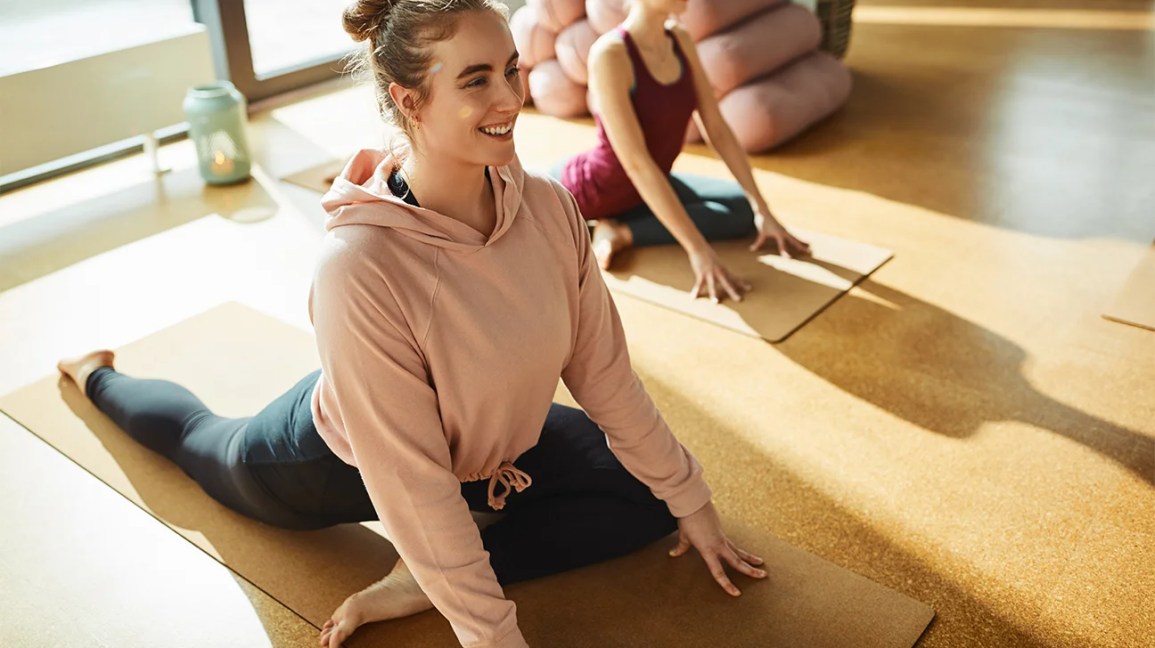Learn how to do the pigeon pose correctly, step-by-step. Improve flexibility and release tension with this beginner-friendly yoga posture.
Pigeon Pose, also known as Eka Pada Rajakapotasana in Sanskrit, is a popular yoga pose that targets the hips and glutes. It is a deep hip opener that can help alleviate stiffness and tightness in the lower body. In this guide, we will break down the steps to help you perform the pigeon pose with proper form and alignment.
Pigeon Pose provides numerous benefits, such as improving hip mobility, increasing range of motion, and relieving tension in the lower back and hips. It also stretches the thighs, groin, and psoas muscles while opening the chest and shoulders. Whether you are a beginner or an experienced yogi, mastering the pigeon pose can enhance your yoga practice and contribute to your overall physical and mental well-being.

How To Perform Pigeon Pose
If you’re looking to stretch your hips and relieve tension in your lower body, pigeon pose is the perfect yoga asana for you. Also known as Eka Pada Rajakapotasana, this pose targets the hip flexors, glutes, and piriformis muscles, promoting flexibility and strength in these areas. In this guide, we’ll break down the steps for performing the pigeon pose correctly, ensuring you get the most out of this rejuvenating posture.
Step 1: Starting Position
Before transitioning into the pigeon pose, find a comfortable seated position on your yoga mat. Sit with a tall spine, shoulders relaxed, and legs extended straight out in front of you. Take a few deep breaths, allowing your body to relax and prepare for the following steps.
Step 2: Transition Into Pigeon Pose
To begin the transition into pigeon pose, bend your right knee and slide your right foot towards your left hip, ensuring that your shin is parallel to the top edge of your mat. Your right heel should be close to your left hip, and the right knee should be at roughly a 90-degree angle.
Next, extend your left leg straight behind you while keeping your hips squared towards the front of the mat. To ensure stability and balance, you can use your hands to support your body, placing them on either side of your right leg or slightly behind your hips. Take a deep breath in, feeling the stretch in your hip flexors and glutes.
Step 3: Adjusting The Pose
While in Pigeon Pose, you may need to make some adjustments to ensure proper alignment and comfort. If you’re feeling any strain or discomfort in your knee, place a folded blanket or towel under your right hip for support.
You can also experiment with different variations of pigeon pose, such as using props like blocks or bolsters to modify the depth of the pose and make it more accessible. As you settle into the pose, focus on breathing deeply and allowing any tension or tightness to release.
Remember to repeat the steps on the other side, starting with your left leg, to ensure balanced stretching and benefits for both hips. Over time, with regular practice, you’ll notice increased flexibility and improved range of motion in your hips.
Pigeon Pose is a robust posture that not only stretches your muscles but also calms the mind. With proper alignment and mindful breathing, this pose can help you find both physical and mental balance. Add Pigeon Pose to your regular yoga routine and experience the rejuvenating effects it has on your body and mind.
Tips For A Successful Pigeon Pose Practice
If you’re diving into the world of yoga, you’ve likely come across the famous pigeon pose. This pose, also known as Eka Pada Rajakapotasana, offers a wide range of benefits, including opening up the hips, stretching the thighs and groin, and improving overall flexibility and balance. To get the most out of your Pigeon Pose practice, follow these helpful tips:
Warm-up Your Body Properly
Before attempting the pigeon pose, it’s essential to warm up your body to avoid injury. Start with a few gentle stretches, such as seated forward folds or cat-cow poses, to prepare your hips, thighs, and lower back for the deep stretch of the pigeon pose. You can also incorporate dynamic movements, like hip circles or lunges, to further warm up the muscles.
Use Props And Modifications
Pigeon Pose can be intense, especially if you have tight hips or limited flexibility. To make the pose more accessible, utilize props and modifications. For instance, if your hips don’t comfortably reach the floor in the pose, place a folded blanket or bolster beneath your hips for support. You can also use blocks to elevate the hands and ease the pressure on the upper body.
If Pigeon Pose feels too challenging, you can try the reclined version, lying on your back and crossing one ankle over the opposite thigh, gently pressing the knee away from the body. This modification still provides a deep stretch without putting excessive strain on the hips and knees.
Focus On Alignment And Breathing
Alignment and breathwork are essential elements of any yoga practice, and pigeon pose is no exception. As you move into the pose, pay attention to the alignment of your hips and knees. The front knee should be positioned at a 90-degree angle while the back leg extends straight behind you. Avoid any pain or discomfort by listening to your body and adjusting the pose as needed.
While in the pose, take slow, deep breaths, allowing your body to relax and release tension. Breathing deeply not only enhances the stretch but also calms the nervous system, promoting a sense of grounding and tranquility.
By incorporating these tips into your Pigeon Pose practice, you can experience a more fulfilling and effective yoga session. Remember to warm up your body correctly, utilize props and modifications, and focus on alignment and breathing throughout the pose. Enjoy the many benefits that pigeon pose brings, both physically and mentally!
Frequently Asked Questions For Pigeon Pose: A How-to Guide
How do you do Pigeon pose step by step?
To do a Pigeon pose, start in a high plank position. Bring your right knee forward towards your right hand, placing the outer edge of your right shin on the mat. Slide your left leg back behind you, straightening it out.
Square your hips and gently lower your upper body down towards the mat. Breathe deeply and hold the pose for a few breaths. Repeat on the other side.
Why Is Pigeon Pose So Difficult?
The pigeon pose is challenging due to its deep hip stretch and requirement for flexibility. It targets hip rotators, glutes, and hip flexors. The pose can be challenging for those with tight hips, limited range of motion, or tight lower back muscles.
Regular practice can improve flexibility and make it easier over time.
How Do You Transition To Pigeon Pose?
To transition to the pigeon pose, start in a plank position. Bring one leg forward, placing the knee behind the same-side wrist. Slide the back leg straight back, ensuring the hips are square. Lower the upper body down and rest on your forearms, or keep your arms extended.
Hold and switch sides.
Why Can’t I Sit Up In Pigeon Pose?
In pigeon pose, sitting up may be difficult due to tight hip muscles, lack of flexibility, or limited range of motion. Stretching and gradually increasing flexibility can help improve your ability to sit up comfortably in this pose.
Conclusion
In sum, mastering the pigeon pose can significantly benefit your physical and mental well-being. By stretching and opening the hips, this
Whether you’re a beginner or an experienced yogi, practicing this pose regularly can help you achieve a deeper mind-body connection and support overall wellness. Start embracing the pigeon pose and reap its numerous rewards today.


